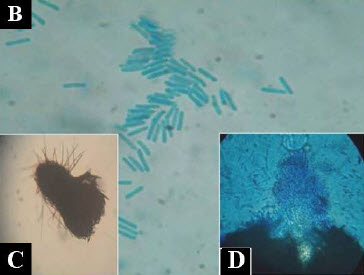First Report of Leaf Spot Disease Caused by Polyrostrata indica on Aloe vera from Madhya Pradesh, India
Keywords:
Aloe vera, Leaf spot, Polyrostrata indica, Disease, IndiaAbstract
A leaf spot disease was observed on Aloe vera plants growing in nurseries and botanical gardens of Gwalior, Madhya Pradesh, India. Symptoms were noticed on the tips and the middle part of the leaves in the form of small, circular, dark brown necrotic spots, with an average diameter of 0.6-1.4×0.5-0.9 cm. Dark brown colonies with granular appearance was consistently isolated from the infected tissue on PDA. Conidia were hyaline, aseptate and rod shaped measuring up to 12.5-20×7.5-15 μm. Based on the morphological and cultural characteristics, fungus was identified as Polyrostrata indica Prameela and Nita Mathur. Pathogenicity test conducted on healthy Aloe leaves showed typical leaf spot symptoms after fourteen day of infestation. To the best of our knowledge, this is the first record of this pathogen on A. vera in India.
References
Abkhoo, J. (2014). Evidence of Alternaria alternata causing leaf spot of Aloe vera in Iran. Journal of Phytopathology, 162(7-8),516-518.
Arunkumar, S., & Muthuselvan, M. (2009). Analysis of Phytochemical Constituents and Antimicrobial Activities of Aloe vera L. against Clinical Pathogens. World Journal of Agricultural Sciences, 5(5), 572-576.
Avasthi, S., Gautam, A. K., & Bhadauria, R. (2016). First report of Cladosporium sphaerospermum causing leaf spot disease of
Aloe vera in India. Journal of Crop Protection 5(4), 649-654.
Avasthi, S., Gautam, A. K., & Bhadauria, R. (2017). First report of leaf spot disease caused by Phoma eupyrena Sacc. on Aloe vera from
Madhya Pradesh, India. Arch Phytopathology Plant Protect, 50 (1&2), 62 –69.
Avasthi, S., Gautam, A. K., & Bhadauria, R. (2013). First report of Phoma betae on Aloevera in India. Arch Phytopathology Plant Protect, 46(12), 1508-1511.
Avasthi, S., Gautam, A. K., & Bhadauria, R.(2016). First report of Phomopsis sp. on Aloevera in India. Plant Pathology and Quarantine, 6(2), 176–179.
Avasthi, S., Gautam, A. K., & Bhadauria, R. (2015a). Occurrence of leaf spot diseases on Aloe barbadensis Miller caused by Curvularia species
from Madhya Pradesh, India, Biodiversitas, 16(1), 79-83.
Avasthi, S., Gautam, A. K., & Bhadauria, R. (2011).First report of anthracnose disease of Aloe vera caused by Colletotrichum gloeosporioides.
Journal of research in Biology, 6(1), 408-410.
Bajwa, R., Mukhtar, I., & Mushtaq, S. (2010). New report of Alternaria alternata causing leaf spot of Aloe vera in Pakistan. Canadian
Journal of Plant Pathology, 32(4), 490-492.
Boudreau, M. D., & Beland, F. A. (2006). An evaluation of the biological and toxicological properties of Aloe barbadensis (Miller). Journal
of environmental science and health. Part C,Journal of Environmental Carcinogenesis and Ecotoxicology, 24(1), 103-154.
Devi,T. P., Mathur, N., Singh, O. P., & Maheswari, C. U. (2009). Polyrostrata, a new genus of Sphaeropsidaceae from India. Indian
Phytopathology, 62(2), 233-236.
Djeraba, A., & Quere, P. (2000). In vivo macrophage activation in chicken with acemannan, complex carbohydrates extracted
from Aloe vera, International Journal of Immunopharmacology, 22(5), 365-372.
Eshun, K., & He, Q. (2004). Aloe vera: A valuable ingredient for the food, pharmaceutical and cosmetic industries - A review. Critical
Reviews in Food Science and Nutrition, 44 (2), 91–96.
Kamalakannan, A., Gopalakrishanan, C., Renuka, R., Kalpana, K., Lakshmi, L. D., & Valluvaparidasan, V. (2008). First report of
Alternaria alternate causing leaf spot on Aloe barbadensis in India. Australian Plant Disease Notes, 3(1), 110-111.
Kamil, D., Sharma, D.K., Devi, T.P., & Singh, M. (2014). First report of leaf blight of Aloe vera caused by Sphaeropsis sapinea in India. Journal of Plant Pathology, 96 (2), 113.
Kawuri, R., Suprapta, D. N., Nitta, Y., & Homma, T. (2012). Destructive Leaf Rot Disease Caused by Fusarium oxysporum on Aloe barbadensis Miller in Bali. Agricultural Science Research Journal, 2 (6), 295 – 301.
Kishi, K., Furukawa, T., & Akot, T. (1999). Purple Spot of Aloe (Aloe arborescens Mill.) Caused by Fusarium phyllophilum Nirenberget O'Donnell (New Disease). Annals of the Phytopathological Society of Japan, 65(6), 576-587.
Park, J. H., & Kwon, S. W. (2006). Chemical components of aloe and its analysis. In: Park, Y. I. & Lee S.K. (Ed.), New perspectives on
Aloe (pp. 23-66). New York: Springer.
Ramachandra, C. T., & Rao, S. P. (2008). Processing of Aloe vera gel: A review. American Journal of Agricultural and Biological Sciences, 3(2), 507-510.
Steenkamp, V., & Stewart, M. J. (2007). Medicinal applications and toxicological activities of Aloe products. Pharmaceutical Biology, 45
(5), 411–20.
Uma Maheswari,C., Prameela Devi, T., Mathur N., & Singh O. P. (2009). Polyrostrata, a new genus of Sphaeropsidaceae from India. Indian
Phytopathology, 62(2), 233-236.
Vakalounakis, D. J., Kavroulakis, N., & Lamprou, K. K. (2015). Occurrence of Leaf Spot Caused by Alternaria tenuissima on Aloe barbadensis in Greece. Plant Disease, doi:10.1094/PDIS-07-15-0803-PDN.
Manjul, P., Shubha, T., Gurha, S. N., & Tripathi V. K. (2008). Dry rot and leaf spot of Aloe barbadensis caused by Alternaria alternata. Journal Annals of Plant Protection Sciences, 16(2): 512-513.
Vogler, B. K. & Enst E. (1999). Aloe vera a systematic review of its clinical effectiveness. British Journal of General Practice, 49(447),
-828.
Yebpella, G. G., Adeyemi, H. M. M., Hammuel, C., Magomya, A. M., Agbaji, A. S., & Okonkwo, E. M. (2011). Phytochemical screening and comparative study of antimicrobial activity of Aloe vera various extracts. African Journal of Microbiology Research, 5(10), 1182-1187.
Zhai, L. F, Liu J., Zhang, M. X., Hong, N., Wang, G. P., & Wang, L. P. (2013). The first report of leaf spots in Aloe vera caused by Nigrospora oryzae in China. Plant Disease, 97(9), 1256.













